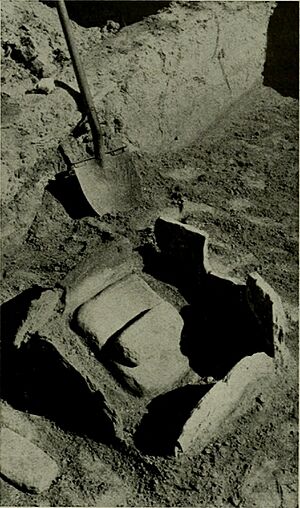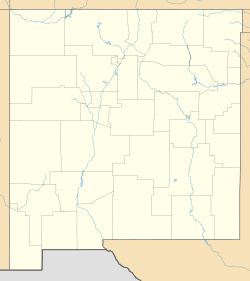Tonque Pueblo facts for kids
|
Tonque Pueblo
|
|
| Nearest city | Tejon Grant, New Mexico |
|---|---|
| Area | 36 acres (15 ha) |
| Built | 1600 |
| NRHP reference No. | 84003045 |
Quick facts for kids Significant dates |
|
| Added to NRHP | January 12, 1984 |
Tonque (TONG-kee) is the name of a large, old pueblo (a type of village built by Native Americans) in New Mexico. It's about 7 miles (12 km) southeast of San Felipe Pueblo. This pueblo was built long before Christopher Columbus arrived in America.
Long ago, Tonque was a very important place for making pottery. It might have made up to one-third of all the special glazed pottery used by other pueblos in the middle Rio Grande valley. Today, Tonque Pueblo is an abandoned ruin.
Contents
What Tonque Pueblo Looked Like
Tonque Pueblo (also known as LA240) was built using adobe (a type of sun-dried brick). It probably never had more than one floor. The pueblo had between 1,500 and 2,000 rooms!
These rooms were arranged in a shape like the letter "E". There were three long sections of rooms that ran from east to west. These sections were about 120 to 280 meters long. They were also 4 to 10 rooms wide. A continuous block of rooms, now mostly gone, was along the west side.
Location and Resources
The pueblo is located on the north side of Tonque arroyo. An arroyo is a dry streambed that only has water after heavy rain. A natural spring (a place where water comes out of the ground) is on the south side.
People living here likely grew crops like corn and beans. They probably farmed the arroyo floor when it flooded.
Many petroglyphs (ancient rock carvings) can be found near Tonque.
The History of Tonque Pueblo

Archaeologists (people who study ancient cultures) believe Tonque Pueblo was first settled in the early 1300s. People lived there until the mid-1500s.
Spanish records from that time don't mention Tonque by name. However, it might be one of two unnamed pueblos visited by Gaspar Castaño de Sosa in 1591. Juan de Oñate also didn't list it in 1598, but it could have been a place he called El Tuerte.
In 1892, a historian named Adolph Francis Alphonse Bandelier said it was a Tano village. He called it Tunque, El-Tunque, Tungee, or Tun-ge. The word tung means "basket" or "tray" in the Tewa language. This suggests it was known as the "Pueblo of Basket Makers."
Why Was Tonque Abandoned?
It's not completely clear why Tonque Pueblo was abandoned. Studies of tree rings in the area show that a serious drought happened in the late 1500s. This means there wasn't enough rain for crops.
Some Pueblo legends also talk about general problems and unrest during that time. Gaspar de Sosa's journal says that two pueblos he visited were abandoned "only days before." He saw signs of many deaths. Natives with his group told him the abandonment was due to war with other tribes.
Evidence from digging at Tonque suggests the pueblo was already becoming less active by then.
Tonque's Pottery Industry
The banks of the arroyo near Tonque had very good clay for pottery. Materials that look like mica (a shiny mineral) were also found nearby. These were used to strengthen the clay. Lead ore and other minerals for making glaze paint were found in the nearby Ortiz Mountains.
The pottery from Tonque was often cream to light orange in color. It had a special crystal tuff material mixed in.
Between about 1350 and 1450 AD, Tonque became a major producer of "glaze-on-yellow" pottery. This pottery was known for its excellent quality, color, and designs. Archaeologists use different "Glaze Periods" (A through C) to date the pottery based on its glaze and patterns.
Some pottery pieces from a later period (Glaze Period F) suggest that people might have returned to Tonque in the late 1600s. However, no other items have been found from the time between the late 1500s and mid-1600s.
Today, many pieces of Tonque pottery are kept at the Maxwell Museum of Anthropology at the University of New Mexico.
Tonque in the 20th Century
In 1912, a brick factory called Tonque Brick and Tile Company was built near the ruins. This happened during the development of coal mining in Hagan, New Mexico, about 4.5 miles (7.5 km) away. The factory used the local clay deposits.
In 1914, an archaeologist named Nels C. Nelson dug up 266 rooms on the western side of the pueblo. Much of this area was later destroyed when the factory dug for more clay. In 1933, the Archaeological Society of Albuquerque High School dug the only known kiva (a special ceremonial room) at Tonque. Amateur archaeologists reported digging 144 rooms in 1969.
A railroad was built in 1924 to serve Hagan and passed just north of the ruins. It also served the brick factory. When the coal mines ran out, the railroad stopped operating in 1933 and was removed. Today, an unpaved road (Indian Service Road 844/Madera Road) follows the old railroad path. The brick factory closed in 1942, and only its foundations remain.
The ruins of Tonque Pueblo are on land owned by San Felipe Pueblo. The site is considered sacred by the Pueblo people. Tonque Pueblo is not open to the public, except for special organized tours.



